Report on Business and Business Environment: SME and Macro Factors
VerifiedAdded on 2020/02/03
|8
|1844
|444
Report
AI Summary
This report provides a comprehensive analysis of the business environment, with a specific focus on Small and Medium-sized Enterprises (SMEs) and their interaction with macro-environmental factors. The report begins by defining different types, scopes, and sizes of organizations, distinguishing between profit and non-profit entities, as well as micro, small, and large companies. It then explores the interrelationships between various business functions, such as marketing, finance, and human resource management, and how these functions are linked to organizational structure, including hierarchical and matrix structures. The report utilizes contemporary examples to demonstrate both the positive and negative influences of the macro-environment on business operations, employing a PESTLE analysis to assess political, economic, social, technological, legal, and environmental factors impacting a specific IT company. Furthermore, a SWOT analysis of TESCO is conducted to determine internal strengths, weaknesses, opportunities, and threats, and their relationship to the macro environment. The report concludes by summarizing the key findings and emphasizing the importance of understanding the business environment for organizational success.
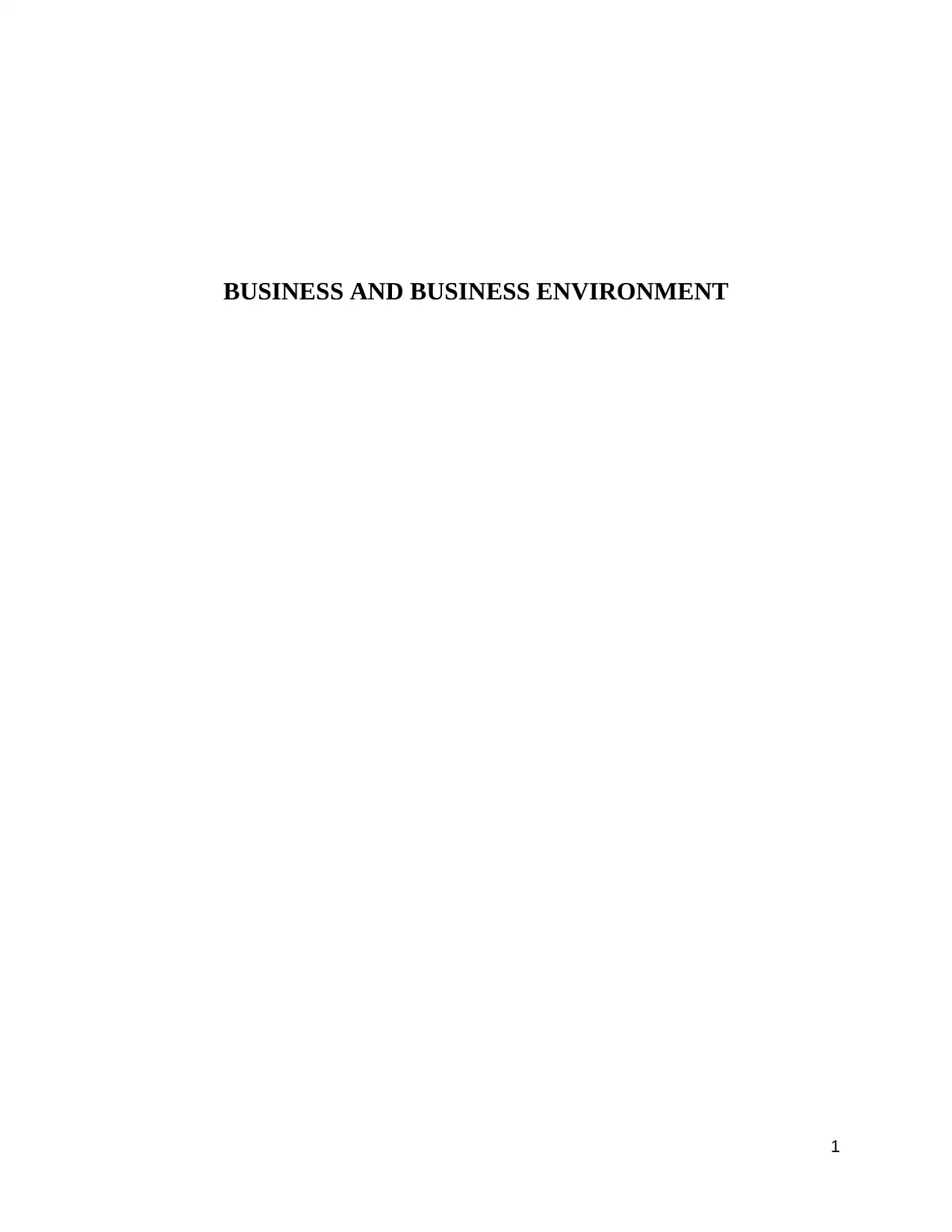
BUSINESS AND BUSINESS ENVIRONMENT
1
1
Paraphrase This Document
Need a fresh take? Get an instant paraphrase of this document with our AI Paraphraser
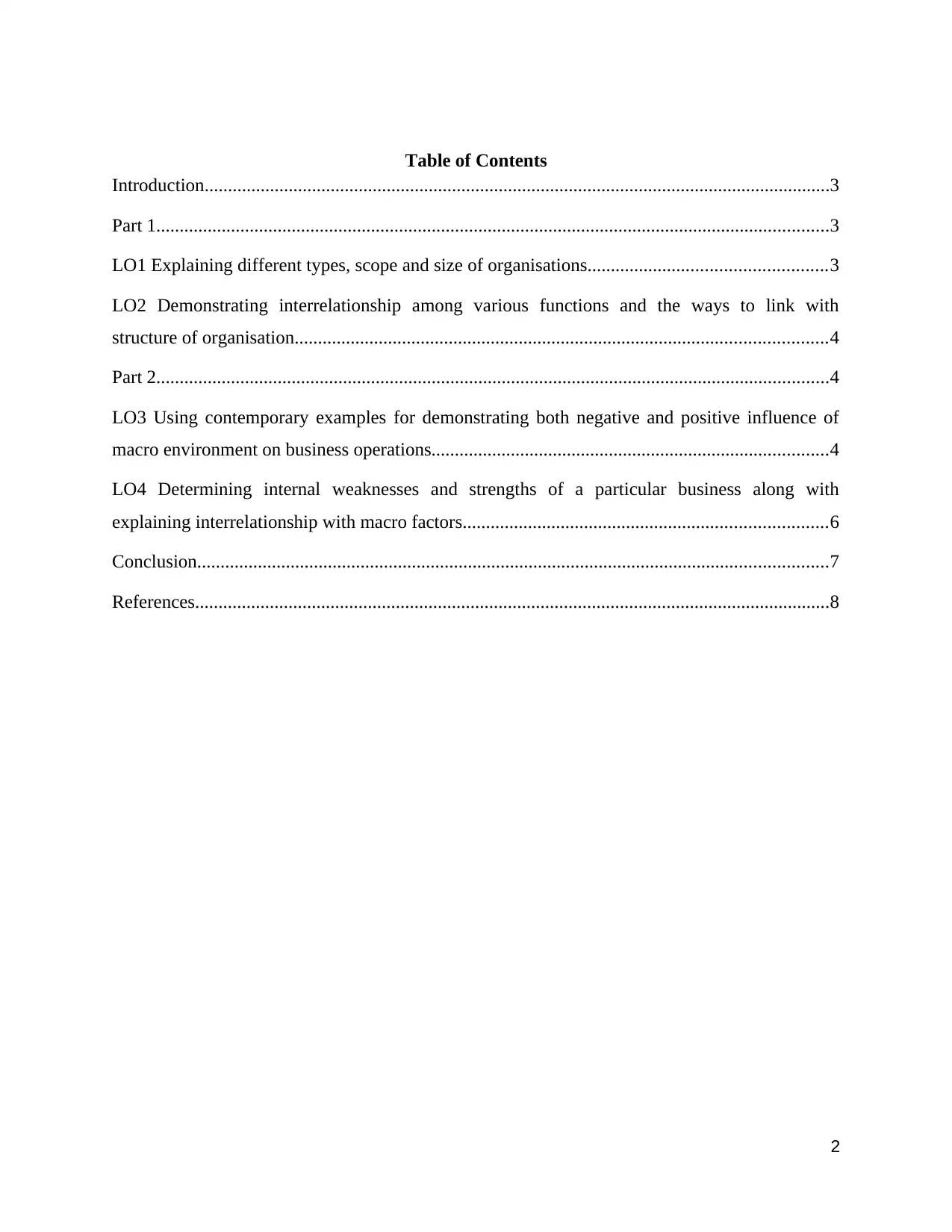
Table of Contents
Introduction......................................................................................................................................3
Part 1................................................................................................................................................3
LO1 Explaining different types, scope and size of organisations...................................................3
LO2 Demonstrating interrelationship among various functions and the ways to link with
structure of organisation..................................................................................................................4
Part 2................................................................................................................................................4
LO3 Using contemporary examples for demonstrating both negative and positive influence of
macro environment on business operations.....................................................................................4
LO4 Determining internal weaknesses and strengths of a particular business along with
explaining interrelationship with macro factors..............................................................................6
Conclusion.......................................................................................................................................7
References........................................................................................................................................8
2
Introduction......................................................................................................................................3
Part 1................................................................................................................................................3
LO1 Explaining different types, scope and size of organisations...................................................3
LO2 Demonstrating interrelationship among various functions and the ways to link with
structure of organisation..................................................................................................................4
Part 2................................................................................................................................................4
LO3 Using contemporary examples for demonstrating both negative and positive influence of
macro environment on business operations.....................................................................................4
LO4 Determining internal weaknesses and strengths of a particular business along with
explaining interrelationship with macro factors..............................................................................6
Conclusion.......................................................................................................................................7
References........................................................................................................................................8
2
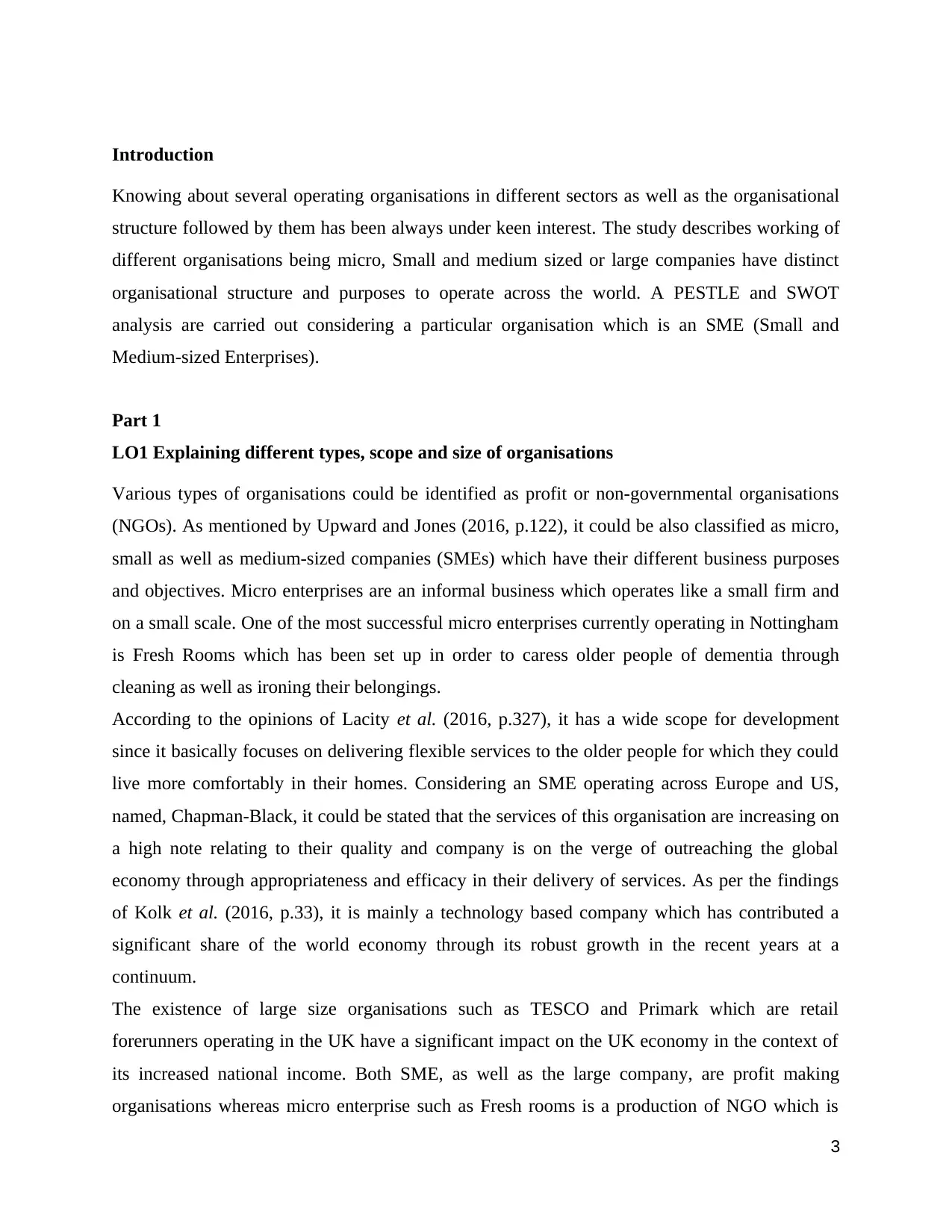
Introduction
Knowing about several operating organisations in different sectors as well as the organisational
structure followed by them has been always under keen interest. The study describes working of
different organisations being micro, Small and medium sized or large companies have distinct
organisational structure and purposes to operate across the world. A PESTLE and SWOT
analysis are carried out considering a particular organisation which is an SME (Small and
Medium-sized Enterprises).
Part 1
LO1 Explaining different types, scope and size of organisations
Various types of organisations could be identified as profit or non-governmental organisations
(NGOs). As mentioned by Upward and Jones (2016, p.122), it could be also classified as micro,
small as well as medium-sized companies (SMEs) which have their different business purposes
and objectives. Micro enterprises are an informal business which operates like a small firm and
on a small scale. One of the most successful micro enterprises currently operating in Nottingham
is Fresh Rooms which has been set up in order to caress older people of dementia through
cleaning as well as ironing their belongings.
According to the opinions of Lacity et al. (2016, p.327), it has a wide scope for development
since it basically focuses on delivering flexible services to the older people for which they could
live more comfortably in their homes. Considering an SME operating across Europe and US,
named, Chapman-Black, it could be stated that the services of this organisation are increasing on
a high note relating to their quality and company is on the verge of outreaching the global
economy through appropriateness and efficacy in their delivery of services. As per the findings
of Kolk et al. (2016, p.33), it is mainly a technology based company which has contributed a
significant share of the world economy through its robust growth in the recent years at a
continuum.
The existence of large size organisations such as TESCO and Primark which are retail
forerunners operating in the UK have a significant impact on the UK economy in the context of
its increased national income. Both SME, as well as the large company, are profit making
organisations whereas micro enterprise such as Fresh rooms is a production of NGO which is
3
Knowing about several operating organisations in different sectors as well as the organisational
structure followed by them has been always under keen interest. The study describes working of
different organisations being micro, Small and medium sized or large companies have distinct
organisational structure and purposes to operate across the world. A PESTLE and SWOT
analysis are carried out considering a particular organisation which is an SME (Small and
Medium-sized Enterprises).
Part 1
LO1 Explaining different types, scope and size of organisations
Various types of organisations could be identified as profit or non-governmental organisations
(NGOs). As mentioned by Upward and Jones (2016, p.122), it could be also classified as micro,
small as well as medium-sized companies (SMEs) which have their different business purposes
and objectives. Micro enterprises are an informal business which operates like a small firm and
on a small scale. One of the most successful micro enterprises currently operating in Nottingham
is Fresh Rooms which has been set up in order to caress older people of dementia through
cleaning as well as ironing their belongings.
According to the opinions of Lacity et al. (2016, p.327), it has a wide scope for development
since it basically focuses on delivering flexible services to the older people for which they could
live more comfortably in their homes. Considering an SME operating across Europe and US,
named, Chapman-Black, it could be stated that the services of this organisation are increasing on
a high note relating to their quality and company is on the verge of outreaching the global
economy through appropriateness and efficacy in their delivery of services. As per the findings
of Kolk et al. (2016, p.33), it is mainly a technology based company which has contributed a
significant share of the world economy through its robust growth in the recent years at a
continuum.
The existence of large size organisations such as TESCO and Primark which are retail
forerunners operating in the UK have a significant impact on the UK economy in the context of
its increased national income. Both SME, as well as the large company, are profit making
organisations whereas micro enterprise such as Fresh rooms is a production of NGO which is
3
⊘ This is a preview!⊘
Do you want full access?
Subscribe today to unlock all pages.

Trusted by 1+ million students worldwide
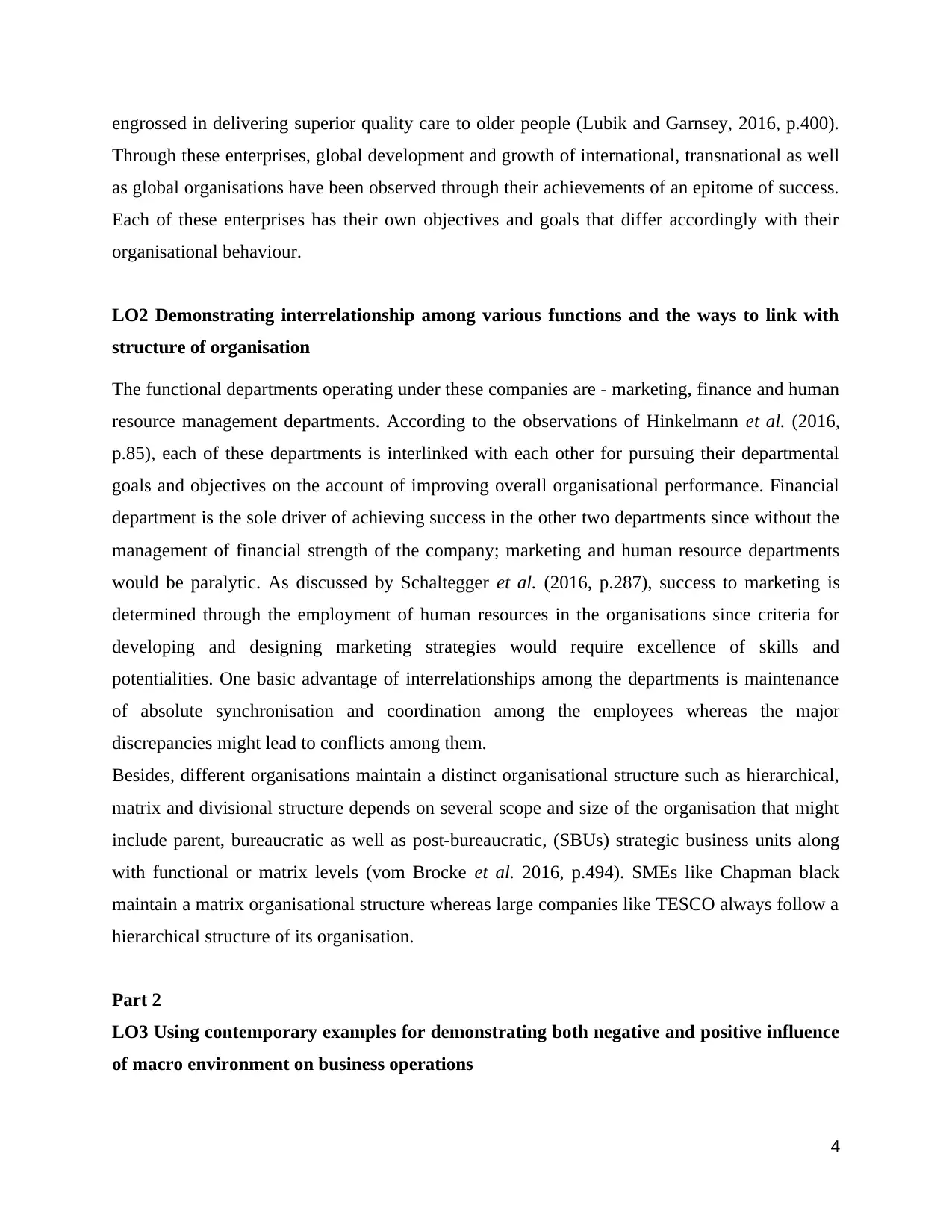
engrossed in delivering superior quality care to older people (Lubik and Garnsey, 2016, p.400).
Through these enterprises, global development and growth of international, transnational as well
as global organisations have been observed through their achievements of an epitome of success.
Each of these enterprises has their own objectives and goals that differ accordingly with their
organisational behaviour.
LO2 Demonstrating interrelationship among various functions and the ways to link with
structure of organisation
The functional departments operating under these companies are - marketing, finance and human
resource management departments. According to the observations of Hinkelmann et al. (2016,
p.85), each of these departments is interlinked with each other for pursuing their departmental
goals and objectives on the account of improving overall organisational performance. Financial
department is the sole driver of achieving success in the other two departments since without the
management of financial strength of the company; marketing and human resource departments
would be paralytic. As discussed by Schaltegger et al. (2016, p.287), success to marketing is
determined through the employment of human resources in the organisations since criteria for
developing and designing marketing strategies would require excellence of skills and
potentialities. One basic advantage of interrelationships among the departments is maintenance
of absolute synchronisation and coordination among the employees whereas the major
discrepancies might lead to conflicts among them.
Besides, different organisations maintain a distinct organisational structure such as hierarchical,
matrix and divisional structure depends on several scope and size of the organisation that might
include parent, bureaucratic as well as post-bureaucratic, (SBUs) strategic business units along
with functional or matrix levels (vom Brocke et al. 2016, p.494). SMEs like Chapman black
maintain a matrix organisational structure whereas large companies like TESCO always follow a
hierarchical structure of its organisation.
Part 2
LO3 Using contemporary examples for demonstrating both negative and positive influence
of macro environment on business operations
4
Through these enterprises, global development and growth of international, transnational as well
as global organisations have been observed through their achievements of an epitome of success.
Each of these enterprises has their own objectives and goals that differ accordingly with their
organisational behaviour.
LO2 Demonstrating interrelationship among various functions and the ways to link with
structure of organisation
The functional departments operating under these companies are - marketing, finance and human
resource management departments. According to the observations of Hinkelmann et al. (2016,
p.85), each of these departments is interlinked with each other for pursuing their departmental
goals and objectives on the account of improving overall organisational performance. Financial
department is the sole driver of achieving success in the other two departments since without the
management of financial strength of the company; marketing and human resource departments
would be paralytic. As discussed by Schaltegger et al. (2016, p.287), success to marketing is
determined through the employment of human resources in the organisations since criteria for
developing and designing marketing strategies would require excellence of skills and
potentialities. One basic advantage of interrelationships among the departments is maintenance
of absolute synchronisation and coordination among the employees whereas the major
discrepancies might lead to conflicts among them.
Besides, different organisations maintain a distinct organisational structure such as hierarchical,
matrix and divisional structure depends on several scope and size of the organisation that might
include parent, bureaucratic as well as post-bureaucratic, (SBUs) strategic business units along
with functional or matrix levels (vom Brocke et al. 2016, p.494). SMEs like Chapman black
maintain a matrix organisational structure whereas large companies like TESCO always follow a
hierarchical structure of its organisation.
Part 2
LO3 Using contemporary examples for demonstrating both negative and positive influence
of macro environment on business operations
4
Paraphrase This Document
Need a fresh take? Get an instant paraphrase of this document with our AI Paraphraser
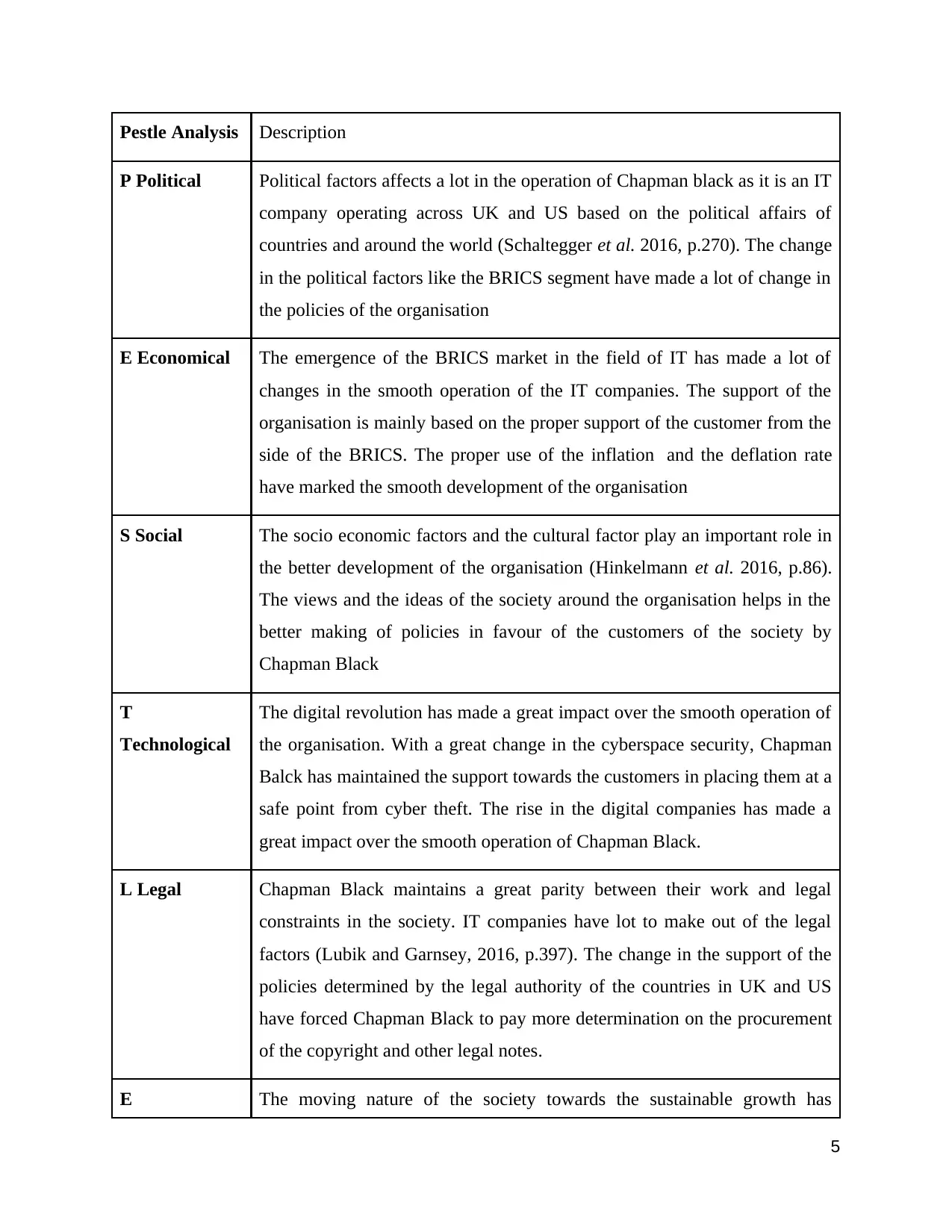
Pestle Analysis Description
P Political Political factors affects a lot in the operation of Chapman black as it is an IT
company operating across UK and US based on the political affairs of
countries and around the world (Schaltegger et al. 2016, p.270). The change
in the political factors like the BRICS segment have made a lot of change in
the policies of the organisation
E Economical The emergence of the BRICS market in the field of IT has made a lot of
changes in the smooth operation of the IT companies. The support of the
organisation is mainly based on the proper support of the customer from the
side of the BRICS. The proper use of the inflation and the deflation rate
have marked the smooth development of the organisation
S Social The socio economic factors and the cultural factor play an important role in
the better development of the organisation (Hinkelmann et al. 2016, p.86).
The views and the ideas of the society around the organisation helps in the
better making of policies in favour of the customers of the society by
Chapman Black
T
Technological
The digital revolution has made a great impact over the smooth operation of
the organisation. With a great change in the cyberspace security, Chapman
Balck has maintained the support towards the customers in placing them at a
safe point from cyber theft. The rise in the digital companies has made a
great impact over the smooth operation of Chapman Black.
L Legal Chapman Black maintains a great parity between their work and legal
constraints in the society. IT companies have lot to make out of the legal
factors (Lubik and Garnsey, 2016, p.397). The change in the support of the
policies determined by the legal authority of the countries in UK and US
have forced Chapman Black to pay more determination on the procurement
of the copyright and other legal notes.
E The moving nature of the society towards the sustainable growth has
5
P Political Political factors affects a lot in the operation of Chapman black as it is an IT
company operating across UK and US based on the political affairs of
countries and around the world (Schaltegger et al. 2016, p.270). The change
in the political factors like the BRICS segment have made a lot of change in
the policies of the organisation
E Economical The emergence of the BRICS market in the field of IT has made a lot of
changes in the smooth operation of the IT companies. The support of the
organisation is mainly based on the proper support of the customer from the
side of the BRICS. The proper use of the inflation and the deflation rate
have marked the smooth development of the organisation
S Social The socio economic factors and the cultural factor play an important role in
the better development of the organisation (Hinkelmann et al. 2016, p.86).
The views and the ideas of the society around the organisation helps in the
better making of policies in favour of the customers of the society by
Chapman Black
T
Technological
The digital revolution has made a great impact over the smooth operation of
the organisation. With a great change in the cyberspace security, Chapman
Balck has maintained the support towards the customers in placing them at a
safe point from cyber theft. The rise in the digital companies has made a
great impact over the smooth operation of Chapman Black.
L Legal Chapman Black maintains a great parity between their work and legal
constraints in the society. IT companies have lot to make out of the legal
factors (Lubik and Garnsey, 2016, p.397). The change in the support of the
policies determined by the legal authority of the countries in UK and US
have forced Chapman Black to pay more determination on the procurement
of the copyright and other legal notes.
E The moving nature of the society towards the sustainable growth has
5
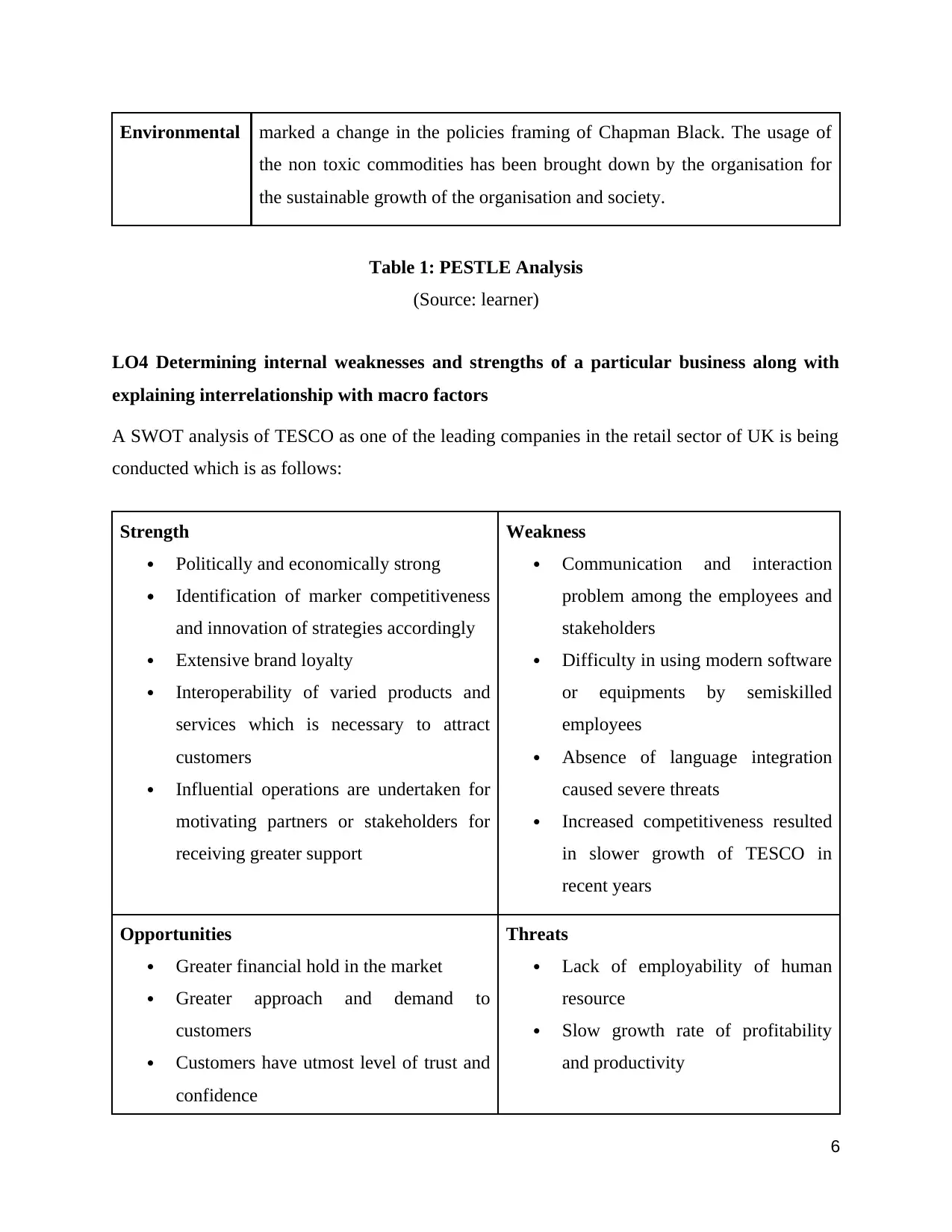
Environmental marked a change in the policies framing of Chapman Black. The usage of
the non toxic commodities has been brought down by the organisation for
the sustainable growth of the organisation and society.
Table 1: PESTLE Analysis
(Source: learner)
LO4 Determining internal weaknesses and strengths of a particular business along with
explaining interrelationship with macro factors
A SWOT analysis of TESCO as one of the leading companies in the retail sector of UK is being
conducted which is as follows:
Strength
Politically and economically strong
Identification of marker competitiveness
and innovation of strategies accordingly
Extensive brand loyalty
Interoperability of varied products and
services which is necessary to attract
customers
Influential operations are undertaken for
motivating partners or stakeholders for
receiving greater support
Weakness
Communication and interaction
problem among the employees and
stakeholders
Difficulty in using modern software
or equipments by semiskilled
employees
Absence of language integration
caused severe threats
Increased competitiveness resulted
in slower growth of TESCO in
recent years
Opportunities
Greater financial hold in the market
Greater approach and demand to
customers
Customers have utmost level of trust and
confidence
Threats
Lack of employability of human
resource
Slow growth rate of profitability
and productivity
6
the non toxic commodities has been brought down by the organisation for
the sustainable growth of the organisation and society.
Table 1: PESTLE Analysis
(Source: learner)
LO4 Determining internal weaknesses and strengths of a particular business along with
explaining interrelationship with macro factors
A SWOT analysis of TESCO as one of the leading companies in the retail sector of UK is being
conducted which is as follows:
Strength
Politically and economically strong
Identification of marker competitiveness
and innovation of strategies accordingly
Extensive brand loyalty
Interoperability of varied products and
services which is necessary to attract
customers
Influential operations are undertaken for
motivating partners or stakeholders for
receiving greater support
Weakness
Communication and interaction
problem among the employees and
stakeholders
Difficulty in using modern software
or equipments by semiskilled
employees
Absence of language integration
caused severe threats
Increased competitiveness resulted
in slower growth of TESCO in
recent years
Opportunities
Greater financial hold in the market
Greater approach and demand to
customers
Customers have utmost level of trust and
confidence
Threats
Lack of employability of human
resource
Slow growth rate of profitability
and productivity
6
⊘ This is a preview!⊘
Do you want full access?
Subscribe today to unlock all pages.

Trusted by 1+ million students worldwide
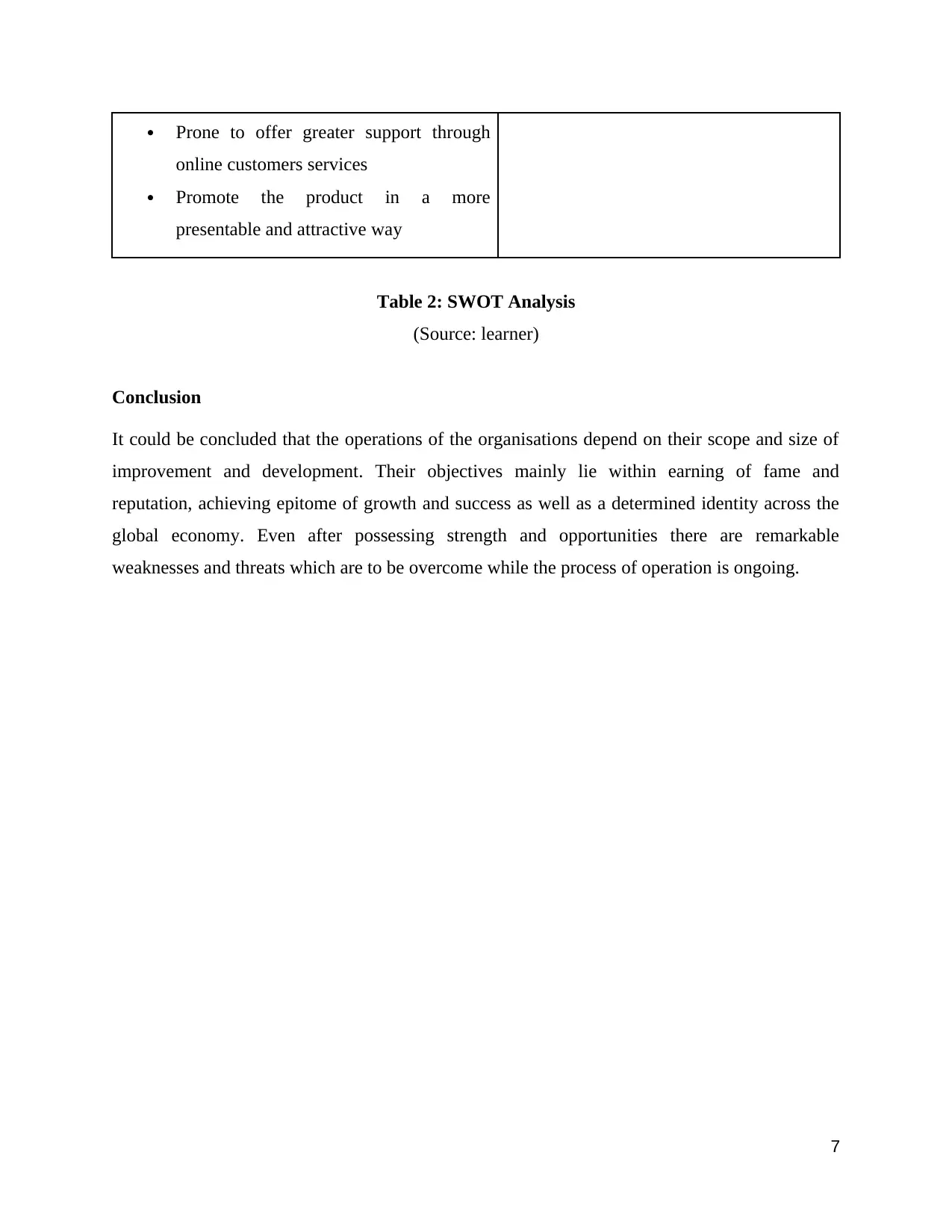
Prone to offer greater support through
online customers services
Promote the product in a more
presentable and attractive way
Table 2: SWOT Analysis
(Source: learner)
Conclusion
It could be concluded that the operations of the organisations depend on their scope and size of
improvement and development. Their objectives mainly lie within earning of fame and
reputation, achieving epitome of growth and success as well as a determined identity across the
global economy. Even after possessing strength and opportunities there are remarkable
weaknesses and threats which are to be overcome while the process of operation is ongoing.
7
online customers services
Promote the product in a more
presentable and attractive way
Table 2: SWOT Analysis
(Source: learner)
Conclusion
It could be concluded that the operations of the organisations depend on their scope and size of
improvement and development. Their objectives mainly lie within earning of fame and
reputation, achieving epitome of growth and success as well as a determined identity across the
global economy. Even after possessing strength and opportunities there are remarkable
weaknesses and threats which are to be overcome while the process of operation is ongoing.
7
Paraphrase This Document
Need a fresh take? Get an instant paraphrase of this document with our AI Paraphraser
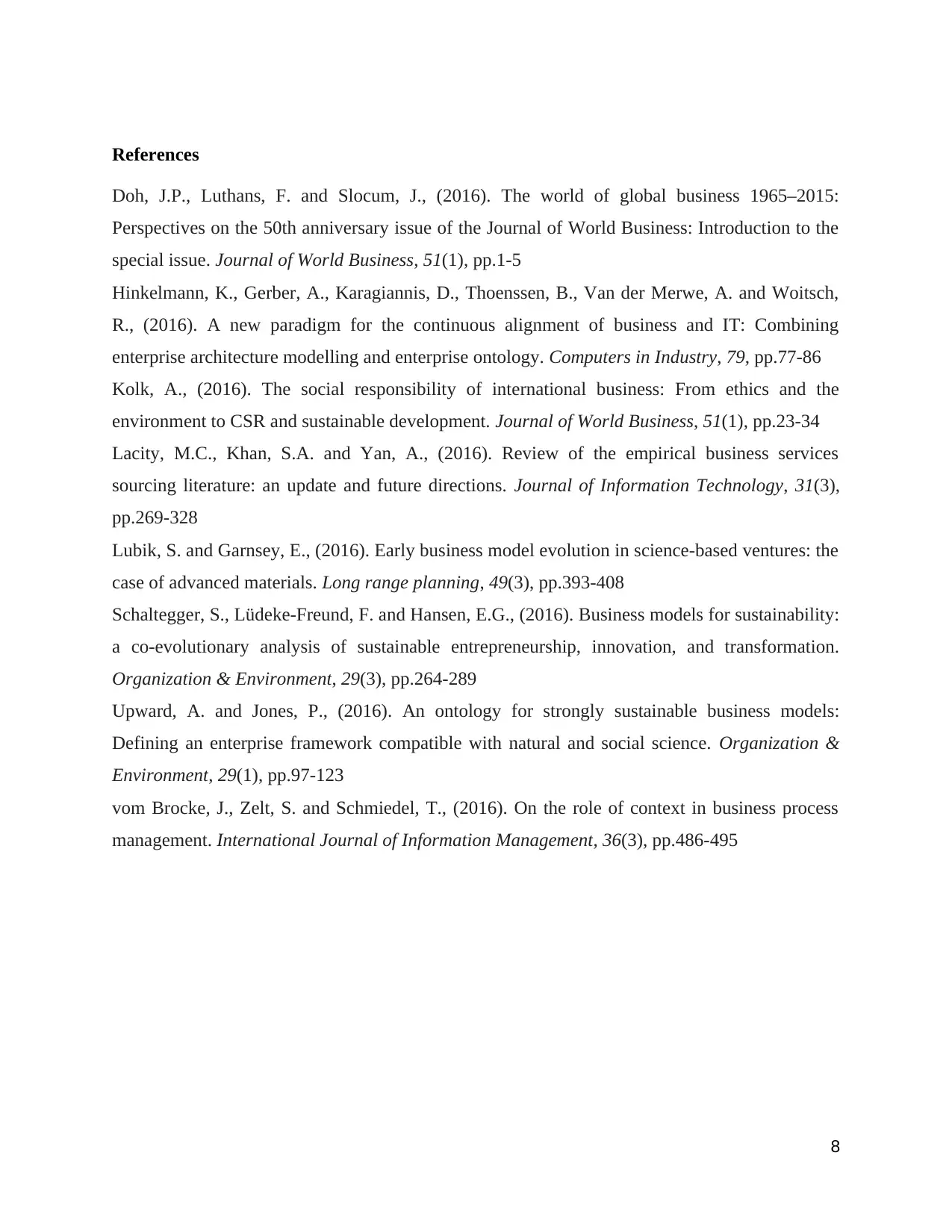
References
Doh, J.P., Luthans, F. and Slocum, J., (2016). The world of global business 1965–2015:
Perspectives on the 50th anniversary issue of the Journal of World Business: Introduction to the
special issue. Journal of World Business, 51(1), pp.1-5
Hinkelmann, K., Gerber, A., Karagiannis, D., Thoenssen, B., Van der Merwe, A. and Woitsch,
R., (2016). A new paradigm for the continuous alignment of business and IT: Combining
enterprise architecture modelling and enterprise ontology. Computers in Industry, 79, pp.77-86
Kolk, A., (2016). The social responsibility of international business: From ethics and the
environment to CSR and sustainable development. Journal of World Business, 51(1), pp.23-34
Lacity, M.C., Khan, S.A. and Yan, A., (2016). Review of the empirical business services
sourcing literature: an update and future directions. Journal of Information Technology, 31(3),
pp.269-328
Lubik, S. and Garnsey, E., (2016). Early business model evolution in science-based ventures: the
case of advanced materials. Long range planning, 49(3), pp.393-408
Schaltegger, S., Lüdeke-Freund, F. and Hansen, E.G., (2016). Business models for sustainability:
a co-evolutionary analysis of sustainable entrepreneurship, innovation, and transformation.
Organization & Environment, 29(3), pp.264-289
Upward, A. and Jones, P., (2016). An ontology for strongly sustainable business models:
Defining an enterprise framework compatible with natural and social science. Organization &
Environment, 29(1), pp.97-123
vom Brocke, J., Zelt, S. and Schmiedel, T., (2016). On the role of context in business process
management. International Journal of Information Management, 36(3), pp.486-495
8
Doh, J.P., Luthans, F. and Slocum, J., (2016). The world of global business 1965–2015:
Perspectives on the 50th anniversary issue of the Journal of World Business: Introduction to the
special issue. Journal of World Business, 51(1), pp.1-5
Hinkelmann, K., Gerber, A., Karagiannis, D., Thoenssen, B., Van der Merwe, A. and Woitsch,
R., (2016). A new paradigm for the continuous alignment of business and IT: Combining
enterprise architecture modelling and enterprise ontology. Computers in Industry, 79, pp.77-86
Kolk, A., (2016). The social responsibility of international business: From ethics and the
environment to CSR and sustainable development. Journal of World Business, 51(1), pp.23-34
Lacity, M.C., Khan, S.A. and Yan, A., (2016). Review of the empirical business services
sourcing literature: an update and future directions. Journal of Information Technology, 31(3),
pp.269-328
Lubik, S. and Garnsey, E., (2016). Early business model evolution in science-based ventures: the
case of advanced materials. Long range planning, 49(3), pp.393-408
Schaltegger, S., Lüdeke-Freund, F. and Hansen, E.G., (2016). Business models for sustainability:
a co-evolutionary analysis of sustainable entrepreneurship, innovation, and transformation.
Organization & Environment, 29(3), pp.264-289
Upward, A. and Jones, P., (2016). An ontology for strongly sustainable business models:
Defining an enterprise framework compatible with natural and social science. Organization &
Environment, 29(1), pp.97-123
vom Brocke, J., Zelt, S. and Schmiedel, T., (2016). On the role of context in business process
management. International Journal of Information Management, 36(3), pp.486-495
8
1 out of 8
Related Documents
Your All-in-One AI-Powered Toolkit for Academic Success.
+13062052269
info@desklib.com
Available 24*7 on WhatsApp / Email
![[object Object]](/_next/static/media/star-bottom.7253800d.svg)
Unlock your academic potential
Copyright © 2020–2025 A2Z Services. All Rights Reserved. Developed and managed by ZUCOL.




